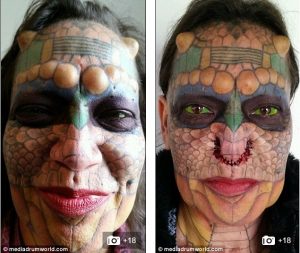From the earliest of ages, some individuals are convinced that their gender and their body are misaligned. CBS News reports, “An 8-year-old second-grader in Los Angeles is a typical patient. Born a girl, the child announced at 18 months, ‘I a boy’ and has stuck with that belief.”[1] Such testimonies are becoming increasingly common, and they are giving rise to ethical and legal dilemmas. Children in the United States as young as four have received sex change therapy, beginning with psychological counseling, followed by hormone blockers when puberty begins, and the option of sex-reassignment surgery when they come of age.[2] Furthermore, in the state of Oregon, 15-year-old children can now receive a sex change operation without parental consent or notice, and the State will pay for it through its Medicaid Oregon Health Plan.[3]
Children in the United States as young as four have received sex change therapy.
In the most extreme cases of gender dysphoria, individuals are not content to merely present as the gender of their choice. Instead, they choose to undergo sex-reassignment surgery. This may involve top surgery, bottom surgery, or both. Psychiatrist Dr. Jack Drescher comments:
[Gender dysphoria is] different from other mental disorders. Usually with a mental disorder, we try and change the person’s mind. This is the only mental disorder where the treatment is changing the body. In a typical mental disorder, we try to make those symptoms go away. Here the treatment has emerged to align the person’s body to match their gender identity.[4]
According to The Encyclopedia of Surgery, “The number of gender reassignment procedures conducted in the United States each year is estimated at between 100 and 500. The number worldwide is estimated to be two to five times larger.”[5]
In the state of Oregon, fifteen-year-old children can now receive a sex change operation without parental consent or notice, and the state will pay for it.
Where such exist, pre-requisites for sex-reassignment surgery do not require objective evidence that the individual is trapped within the wrong body. Instead, the recommendation of mental health specialists and a history of hormonal therapy qualify as sufficient evidence.[6] This is because there is no objective standard for determining whether an individual’s gender identity is misaligned with their physical body. In answer to the question, “How do I know if I’m transgender?” LPC and gender therapist Dara Hoffman-Fox suggests, “Does it feel like your physical body matches the gender that you can tell you are in your brain?”[7] Somehow personal and subjective feelings have become the standard for determining the medical necessity of sex-reassignment surgery. This is because the assumption is that the way an individual feels about themselves is the highest standard for determining reality. Moreover, nobody has the right to question anyone’s personal feelings about themselves … at least when it comes to the subject of gender identity.
Personal and subjective feelings have become the standard for determining the medical necessity of sex-reassignment surgery.

With such a malleable standard, it is not surprising to find that people self-identify as far more than the opposite sex. There are numerous growing subcultures of individuals who believe themselves to be trans labeled. Former National Association for the Advancement of Colored People (NAACP) chapter president Rachel Dolezal created a national controversy in 2015 when it was discovered that she had no African-American ancestry. Her parents are primarily of Czech, German, and Swedish origins; nevertheless, Dolezal considers herself to be transracial and informed Matt Lauer at Today, “I identify as black.”[8], [9] She explained that as early as the age of five, “I was drawing self-portraits with the brown crayon instead of the peach crayon, and black curly hair.”[10]
There are numerous growing subcultures of individuals who believe themselves to be trans labeled.
Similarly, transabled individuals identify with the physically handicapped. Also known as Body Integrity Identity Disorder, Alexandre Baril explains:
We define transability as the desire or the need for a person identified as able-bodied by other people to transform his or her body to obtain a physical impairment … The person could want to become deaf, blind, amputee, paraplegic. It’s a really, really strong desire.[11]
Amber Shuping made international headlines when she allowed a sympathetic psychologist to pour drain cleaner into both of her eyes. From the time she was a little girl, Amber had dreamed of being blind, and she felt compelled to bring her body into conformity with her identity.[12]

When identity is divorced from objective reality, anything becomes possible. Fictives are people who believe “their true identity is a fictional character, often from a series of fantasy novels or a Japanese role-playing game.”[13] Similarly, according to the book Otherkin Timeline:
People who call themselves otherkin (meaning “kin to the other”) look human, but identify as supernatural entities ordinarily thought of as legendary or mythological, most commonly elves, Fae, and dragons, but many other kinds of creatures are represented as well.[14]
These individuals believe they have been born into the wrong body.[15] Richard Hernandez believes he is truly a female dragon named Eva Tiamat Medusa. The Daily Mail reports:
A transgender former banker claims to be the first and only person to have both ears cosmetically removed as part of her ongoing quest to become a “dragon”. … the 55-year-old has undergone a number of painful procedures over the past few years including nose modification, tooth extraction and eye colouring. She also has a forked tongue and a full-face tattoo as part of her transformation into a “mythical beast”. … She has also had horns implanted onto her forehead, and tattoos and scarification on her face and chest that resemble reptilian scales. … On her website, Tiamat explains: “I am the Dragon Lady, A pre-op M2F (male to female) transgender in the process of morphing into a human dragon, becoming a reptoid as I shed my human skin and my physical appearance and my life as a whole leaving my humanness behind.” She adds that she wants to embrace her “most natural self awareness as a mythical beast.”[16]
When identity is divorced from objective reality, anything becomes possible.
Likewise, there is a growing community of individuals who believe they suffer from species dysphoria.[17] According to Otherkin Timeline, “People who call themselves therianthropes (meaning ‘animal people’) look human, but identify as animals, most commonly wolves or felines, but many other kinds of animals are represented as well.”[18] At the age of sixteen, a woman in Norway “discovered” that she is truly a cat who was born into a human body. The Telegraph reports:
[S]he has a superior sense of hearing and sight which allows her to hunt mice in the dark. … The young woman shows off her cat characteristics by wearing fake ears and an artificial tail. She communicates by meowing. … The cat woman wears a pair of pink fluffy paws with which to groom herself, and feels especially like doing so when she is in contact with water. When asked if she was born as the wrong species, she said: “Yes, born in the wrong species.”[19]

As with those who suffer from gender dysphoria, Daniel Greenfield reports, “Transpecies Americans create special pronouns for themselves and insist that refusing to pretend that they’re cats or wolves is a hate crime.”[20] Fundamentally, what is different between a transspecies individual who seeks affirmation of their animal identity because they wear tails, ears, and paws in public and a transgender individual who seeks affirmation of their gender identity because they wear clothes and paraphernalia of that gender in public? Fundamentally, what is different from a transable individual who feels compelled to damage parts of their body in order to bring it into conformity with their handicap identity and a transgender individual who feels compelled to undergo hormone injections and surgery to bring their body into conformity with their gender identity? Fundamentally, what is different between a transracial individual who knows they are African-American because they drew pictures of themselves with brown skin and curly hair when they were five and a transgender individual who knows they are the other gender because they preferred to dress and play with the toys of that gender since they were very young?
Body and brain are interconnected; there is no separate innate “gender” area of the brain which is fixed at birth.
When reality is divorced from objective truth, anything becomes possible. In seeking to answer the question, “Is it possible to be born in the wrong body?” Transgender Trend writes:
The idea that the brain and body are split, and that it is possible to have the brain of one sex and the body of the opposite, is a very recent idea which is unsupported by any credible scientific evidence.
Body and brain are interconnected; there is no separate innate “gender” area of the brain which is fixed at birth. Children’s brains are very plastic; they develop through interaction with people and the environment and they are constantly absorbing information and influences which shape them.
Research in neuroscience consistently confirms that there is no “male” or “female” brain and that all children are born with the potential to develop their own unique characteristics of behaviour, interests, talents and personality, regardless of their biological sex.[21]
Our experiences and habits restructure our brains, thereby establishing and influencing our personality, mannerisms, preferences, and ways of thinking. The brain and the body work in tandem, each influencing the other. The idea that the true essence of our selves can be reduced to neural synapsis firing in our brains, unaffected by and distinct from the remainder of our physical bodies, harkens back to the ancient teaching of Gnosticism. Theologian R.C. Sproul writes:
The Greeks viewed man as a creature locked in a conflict between two opposing and irreconcilable substances, the body and the soul. To the Greek the soul is eternal and good, the body is temporal and intrinsically imperfect. For Plato the nonmaterial ideal realm is the realm of the good. The physical is at best an imperfect receptacle or copy of the ideal. Hence the view emerged in Greek philosophy that the body is the prison house of the soul. Redemption means the release of the soul from the body.[22]
Put another way, Jesse Johnson writes, “Gnostics were a first-century cult that taught that matter didn’t matter. More precisely, they held that our physical bodies were vulgar and thus lacked value, while our inner spiritual state represented true reality.”[23] Recognizing the parallels between Gnosticism and transgenderism, theologian Russell Moore warns against falling prey to this cultural narrative of transgenderism:
This narrative is rooted in the ancient heresy of Gnosticism, with the idea that the “real” self is separate from who one is as an embodied, material being. Body parts and chromosomal patterns are dispensable since the self is radically disconnected from the body, the psychic from the material. The old Gnostic heresy is joined with contemporary expressive individualism—the idea that I must be true to whomever I perceive my “real me” to be on the inside in order to be “authentic.”[24]
We are more than the product of our brains.
In reality, our true selves are not merely a neural network of electrical impulses firing inside our brains. In fact, the near-death experience of Pam Reynolds indicates that human consciousness may be housed somewhere outside the brain. In his book The Supernatural Worldview, Christian apologist Chris Putnam recounts:
Reynolds endured an exotic surgical procedure called “Operation Standstill” to remove a life-threatening aneurysm on her brain stem. The procedure entails stopping the heart, and the blood is drained from the brain to allow the aneurysm to be removed. Even more, the body temperature is lowered to 60 degrees while fully anesthetized with sound-emitting earplugs to verify flat brainwave activity on an EEG.[25]
Despite the fact that Reynold’s heart was stopped, her brain was drained of blood, and her brainwave activity was flat-lined, Reynolds was later able to describe conversations that the doctors had during her operation and the surgical tools they used which hadn’t been revealed before her operation. Chris Putnam writes:
Neuroscientist Mario Beauregard argues that her case suggests that “mind, consciousness and self can continue when the brain is no longer functional and the clinical criteria of death have been reached.” In other words, this seriously challenges the materialist paradigm, which entails that the mind is simply a product of electrochemical brain processes.[26]
We are more than the product of our brains. The Bible teaches in 1 Thessalonians 5:23 that we are a combination of body, soul, and spirit, “Now may the God of peace himself sanctify you completely, and may your whole spirit and soul and body be kept blameless at the coming of our Lord Jesus Christ.” Where each of these begins and ends may be beyond our ability to discern. Hebrews 4:12 teaches, “[T]he word of God is living and active, sharper than any two-edged sword, piercing to the division of soul and of spirit, of joints and of marrow, and discerning the thoughts and intentions of the heart.” Regardless, we know that we are more than a physical body, and likewise, we are more than a spiritual being. According to the Bible, we are the combination of that which is spiritual, and that which is physical. As R.C. Sproul writes, “The Christian doctrine of substantial dichotomy is not dualistic. Man is not a dualism but a duality. That is, we have a real body (material substance) and a real soul (immaterial substance).”[27] This is why we as Christians anticipate the resurrection of the dead. We know that although our spirit can exist apart from the body, we are not complete apart from our bodies. R.C. Sproul writes, “For the Christian, redemption is of the body, not from the body.”[28]
We are the combination of that which is spiritual, and that which is physical.
When God created mankind, He first formed a body from the dust of the earth. However, it was not until He breathed the breath of life into that body that the man became a living creature. Genesis 2:7 says, “[T]hen the LORD God formed the man of dust from the ground and breathed into his nostrils the breath of life, and the man became a living creature.” Our spirits are not pre-existing entities in search of physical bodies. Rather, God creates both our spirit and our body. As such, they are not misaligned. We cannot accidentally find ourselves in the wrong body.
An individual’s sex is established by the objective standards of both biology and the Bible.
Realizing this, personal feelings cannot determine our biological sex. The presence of a Y chromosome establishes an individual as male, and the absence of a Y chromosome establishes an individual as female. This is a biological certainty regardless of chromosome mutations and sex organ anomalies. Biology expert Regina Bailey explains:
In sex chromosomes, nondisjunction results in a number of abnormalities. Klinefelter syndrome is a disorder in which males have an extra X chromosome. The genotype for males with this disorder is XXY. People with Klinefelter syndrome may also have more than one extra chromosome resulting in genotypes which include XXYY, XXXY, and XXXXY. Other mutations result in males that have an extra Y chromosome and a genotype of XYY. … Tuner syndrome is a condition that affects females. Individuals with this syndrome, also called monosomy X, have a genotype of only one X chromosome (XO). Trisomy X females have an additional X chromosome and are also referred to as metafemales (XXX) (emphasis added).[29]
There is no third gender. As Jesus says in Mark 10:6, “[F]rom the beginning of creation, ‘God made them male and female.’” Being in perfect agreement with one another, an individual’s sex is established by the objective standards of both biology and the Bible.
- “Sex-Change Treatment for Kids on the Rise.” ↵
- Ibid. ↵
- Springer, “Oregon Allowing 15-Year-Olds to Get State-Subsidized Sex-Change Operations.” ↵
- Jayson, “What ‘Transgender’ Means, and How Society Views It.” ↵
- Encyclopedia of Surgery, The, “Sex Reassignment Surgery.” ↵
- Philadelphia Center for Transgender Surgery, “Prerequisites.” ↵
- Hoffman-Fox, “Ask a Gender Therapist: How Do I know If I’m Transgender? ↵
- “Rachel Dolezal.” ↵
- Kim, “Rachel Dolezal Breaks Her Silence on TODAY: ‘I Identify as Black’.” ↵
- Ibid. ↵
- Boesveld, “Becoming Disabled by Choice, Not Chance: ‘Transabled’ People Feel Like Impostors in Their Fully Working Bodies.” ↵
- “A Dr. Phil Daytime Exclusive: The Woman Who Put Drain Cleaner in Her Eyes to Fulfill Her Dream of Being Blind.” ↵
- Read, “From Otherkin to Transethnicity: Your Field Guide to the Weird World of Tumblr Identity Politics.” ↵
- Scribner, “Otherkin Timeline: The Recent History of Elfin, Fae, and Animal People, v. 2.0.” ↵
- Read, “From Otherkin to Transethnicity: Your Field Guide to the Weird World of Tumblr Identity Politics.” ↵
- Blott, “Transgender Former Banker, 55, Has Her Ears and Nose REMOVED to Transform Into a ‘Dragon Lady’ with Scales, a Forked Tongue and a Horned Skull.” ↵
- Mralcahuete, “People Who Think They Are Animals Trapped In Human Bodies.” ↵
- Scribner, “Otherkin Timeline: The Recent History of Elfin, Fae, and Animal People, v. 2.0.” ↵
- Horton, “Woman Says She Is a Cat Trapped in the Wrong Body – She Hisses at Dogs, Hates Water and Claims She Can Even See Better at Night.” ↵
- Greenfield, “Forget Transgender, Get Ready for Transpecies.” ↵
- “Born in the Wrong Body?” ↵
- Sproul, R.C. “The Origin of the Soul.” ↵
- Johnson, “Transgendered Gnosticism.” ↵
- Moore, Russell. “What Should the Church Say to Bruce Jenner?” ↵
- Putnam, The Supernatural Worldview, 158. ↵
- Ibid, 159. ↵
- Sproul, R.C. “The Origin of the Soul.” ↵
- Ibid. ↵
- Bailey, “Sex Chromosome Abnormalities.” ↵
